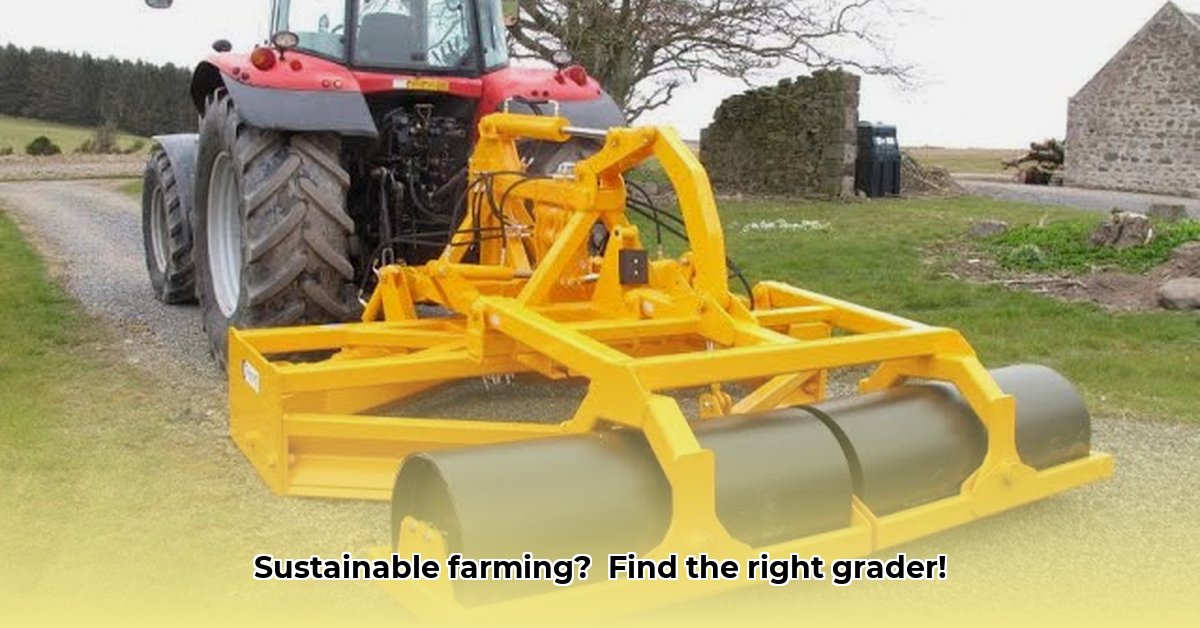
Tractor Driveway Graders: Leveling Up Your Farm's Sustainability
Efficient land leveling is crucial for sustainable farming. It optimizes water use, improves crop yields, and minimizes soil erosion. But choosing the right equipment can be tricky. This guide helps you select the best tractor driveway grader for your specific needs and farming practices, promoting both efficiency and environmental responsibility. We'll explore different grader types, examine key factors to consider during selection, and provide a step-by-step process to guide your decision. For more options, check out these compact tractor attachments.
Figuring Out Your Needs: A Farm-Specific Checklist
Before diving into grader options, assess your farm's unique characteristics. This crucial first step ensures you choose the right tool for the job.
Farm Size: A small-scale operation requires different equipment than a large farm. Consider the acreage you need to level. Do you need a small, maneuverable grader, or a larger, more powerful machine?
Soil Type: Soil composition significantly impacts implement choice. Clay soil, sandy loam, and silty clay all require different approaches. Incorrect equipment selection can lead to soil damage and reduced efficiency. Heavy clay soils, for example, might necessitate a more robust grader.
Farming Goals: Define your objectives. Are you aiming for extremely precise leveling for irrigation, simply smoothing the land for planting, or addressing existing erosion? This shapes your equipment requirements.
Budget: Graders vary significantly in price. Establishing a budget early prevents overspending and ensures you can make balanced decisions. Remember to include maintenance costs in your budget.
Types of Land-Leveling Implements: A Field Guide to Graders
Several implements efficiently level land, each offering unique advantages and disadvantages.
Box Scrapers: These are heavy-duty implements excellent for initial rough leveling and moving large quantities of soil. They are workhorses, perfect for the initial grading pass. However, they lack the precision needed for final leveling.
Blade Graders: Ideal for fine-tuning after initial leveling, blade graders offer precise control for creating level surfaces. They are the finishing tools, ensuring even terrain after the initial rough work.
Chain Harrows: These gently level and break up soil clods, minimizing compaction. They're best for lighter soil preparation and surface work, improving soil aeration.
Land Levelers: Often combining features of box scrapers and blade graders, land levelers provide versatility but typically come with a higher price tag.
Choosing Your Perfect Grader: Key Factors to Consider
Beyond the basic types, several factors significantly influence your choice:
Working Width: Wider working widths increase efficiency for larger fields but reduce maneuverability in smaller areas. Consider your field size and the need for precision.
Durability: Invest in robust construction, particularly for challenging soil conditions. Durability ensures the equipment lasts for years, minimizing replacement costs.
Maintenance: Easy maintenance reduces downtime and expense. Choose a grader known for its simple and straightforward maintenance procedures.
Tractor Compatibility: Ensure compatibility with your tractor's hydraulic system and horsepower rating for safe and effective operation.
Sustainable Farming and Your Grader: A Greener Approach
Sustainable agriculture prioritizes minimizing environmental impact. Consider these sustainability factors when choosing a grader:
Soil Compaction: Excessive compaction harms soil health. Choose implements that minimize compaction, such as chain harrows, or utilize techniques to ameliorate compaction.
Erosion Control: Proper leveling minimizes erosion. However, aggressive grading can increase erosion. A carefully planned approach is crucial.
Fuel Efficiency: Modern graders offer improved fuel efficiency, reducing your carbon footprint and operating costs. Research fuel consumption ratings before making a purchase.
Your Step-by-Step Guide to Grader Selection
Soil Assessment: Conduct a thorough soil analysis to understand its type, drainage, and existing issues. This informs equipment selection.
Goal Definition: Clearly articulate your leveling goals: irrigation, planting, erosion control, etc.
Budgeting: Estimate leveling costs, factoring in maintenance.
Comparative Analysis: Research different graders, comparing features, specifications, and costs.
Expert Consultation: Consult with agricultural experts for personalized recommendations.
Test (If Possible): If feasible, test different graders on your land conditions.
Maintenance Planning: Develop a regular maintenance schedule to prolong equipment lifespan.
By following these steps, you can select a tractor driveway grader that optimizes your farming efficiency while promoting sustainability. Remember, this is an investment in your land's health and the long-term success of your farm.